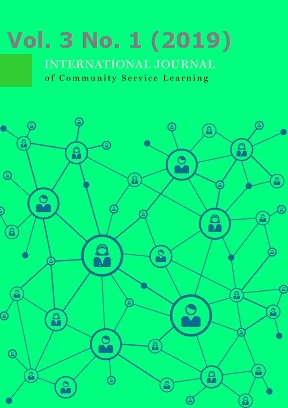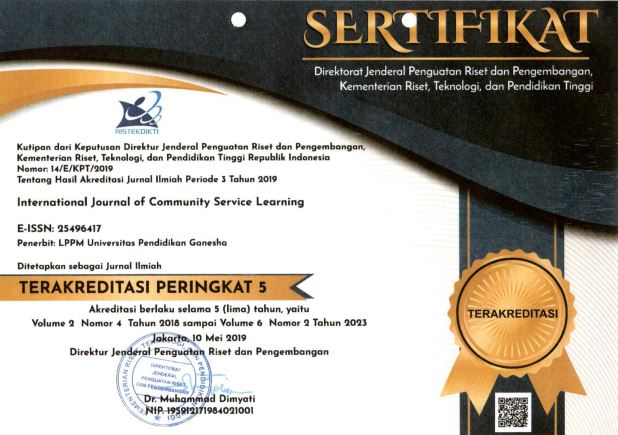PENYULUHAN DAN PENDAMPINGAN PADA KORBAN SELAMAT PERCOBAN BUNUH DIRI DI GUNUNG KIDUL
DOI:
https://doi.org/10.23887/ijcsl.v3i1.17398Abstract
Suicide is a global problem. According to the WHO in 2015 more than 800,000 people / year died from suicide. The average number of Indonesians who died from suicide reached 24 per 100,000 inhabitants. at present the suicide case in Gunungkidul shifts to productive age. The increase in suicides in Gunungkidul is a problem that must be dealt with together. The purpose of this activity is to increase knowledge, and mental health for survivors, families, and communities in Gunungkidul and to prevent rising suicide rates in Gunungkidul. The method applied in this activity is counseling and mentoring. The impact gained is an increase in family and community knowledge about endurance and the role that can be taken in preventing suicide in the surrounding environment, in addition it is expected to restore psychological and spiritual pressure to the victim so as not to commit suicide again.
References
Almeida, O. P., B. Draper, J. Snowdon, N. T. Lautenschlager, J. Pirkis, G. Byrne, M. Sim, N. Stocks, L. Flicker, dan J. J. P. (2012). Factors Associated with Suicidal Thoughts in A Large Community Study of Older Adults. The British Journal of Psychiatry.201, 466–472.
Andari, S. (2017). Fenomena Bunuh Diri di Kabupaten Gunung Kidul. Jurnal Sosio Konsepsia, 7(1), 92–107.
Centre For Disease Control and Prevention. (2016). Suicide. Retrieved from www.cdc.gov/ViolencePrevention/suicide/index.html
Cho, Y., & Haslam, N. (2010). Suicidal Ideation and Distress Among Immigrant Adolescents: The Role of Acculturation, Life Stress, and Social Support. Journal Youth Adolescence, 39, 370–379. https://doi.org/10.1007/s10964-009-9415-y
Davison, G. C., Neale, J. M., & Kring, A. M. (2006). Psikologi Abnormal. Penerjemah: Noermalasari Fajar. Jakarta: PT.Grafindo Persada.
Blazer, D., G. (2000). Mood Disorders: Epidemiology Comprehensive Textbook Of Psychiatry. Philadelphia: Lippincott Williams & Wilkins.
Firestone, R. W. (2007). Suicide and The Inner Voice: Risk Assesment, Treatment, and Case Management. Los Angeles: SAGE Publications.
Greydanus, D. E., Bacopoulou, F., & Tsalamanios, E. (2009). Suicide in Adolescents: A Worldwide Preventable Tragedy. Keio J Med, 58(2), 95–102.
Hook J. N., Worthington E. L., Jr, Davis D. E., Jennings D. J. 2nd, Gartner A. L., & Hook J. P. (2010). Empirically Supported Religious and Spiritual Therapies. Journal of Clinical Psychology, 66(1), 46—72.
Kaplan, H. I., Saddock, B. J., & Grebb, J. A. (2010). Sinopsis Psikiatri: Ilmu Pengetahuan Perilaku Psikiatri Klinis. Jakarta: Bina Rupa Aksara.
Kedaulatan Rakyat. (2016). Misteri Pulung Gantung Belum Terungkap: Tinggi Angka BunuhDiri di Gunungkidul. Yogyakarta.
Kompas. (2017). Tren Kasus Bunuh Diri di Gunung Kidul Bergeser ke Usia Produktif. Retrieved from http://regional.kompas.com/read/2017/07/10/14440781/tren.kasus.bunuh.diri.di.%0Agunungkidul. bergeser.ke.usia.produktif%0A.
Notoatmojo. (2010). Ilmu Perilaku Kesehatan. Jakarta: PT Rineka Cipta.
Nugrawati, Nursalam, & Akhir, M. (2016). Gantung Diri sebagai Penyimpangan Social Terhadap Norma Agama. Jurnal Equilibrium Pendidikan Sosiologi, 9(1), 11–19.
Undang-Undang Nomor 18 tahun 2014 Tentang Kesehatan Jiwa. Jakarta: Republik Indonesia.
O’Connor, R. C., & Knock, M. K. (2014). Suicide 2. The Psychology Of Suicidal Behavior (1st ed.). Lancet Psychiatry.
Okenews. (2019). Karena Depresi, Banyak Warga Gunungkidul Bunuh Diri. Retrieved from https://news.okezone.com/read/2019/03/02/510/2024954/karena-depresi-banyak-warga-gunungkidul-bunuh-diri.
Pratiwi, J. & Undarwati, A. (2014). Suicide Ideation pada Remaja di Kota Semarang. Jurnal Developmental and Clinical Psychology, 3(1), 24– 34.
Razak, A., Mokhtar, M. kamal, & Sulaiman, W. S. W. (2013). Terapi Spiritual Islami Suatu Model Penanggulangan Gangguan Depresi. Jurnal Dakwah Tabligh, 14(1), 141–151.
Satrianegara, M. F. (2014). Pengaruh Religiusitas Terhadap Tingkat Depresi, Kecemasan, Stres dan Kulaitas Hidup Penderita Penyakit Kronis di Kota Makassar. Jurnal Kesehatan, VII(1), 288–304.
Vijayakumar, L., & Nagarai, K. (2004). Suicide and Suicide Prevention in Developing Countries, Disease Control Priorities Project , p. 24.
WHO. (2012). Depression, A Global Public Health Concern. WHO Departemen Mental Health Substance Abuse, 6–8.
Downloads
Published
How to Cite
Issue
Section
License

International Journal of Comunnity Service Learning is licensed under a Creative Commons Attribution-ShareAlike 4.0 International License.













